
10 Ways to Optimize Your Website for Local SEO
Local SEO is a hot topic for Google and it makes sense - we're all looking for things physically near us! Don't forget that local SEO is a great investment, but you'll also want to make sure not to ignore other ways your retail or brick and mortar location can capitalize on digital. Now local SEO has a tendency to be a little confusing and seems to be a bit of a black hole to some folks, however, we have broken down the top 10 ways to optimize your website for local SEO for your browsing pleasure!
1. Optimize Your Homepage.
Your homepage should very clearly state who you are, where you're located and what you do. Make it easy on Google to understand these elements of your business. Your page title tag, header tag and meta description should clearly state this information. If you're using WordPress to build your website, you can easily update your website page title tag under Settings > General in the left navigation. You can also easily load your page meta data via the Yoast SEO plugin, which brings me to my next point.
2. Optimize Your Meta Data.
There has been a lot of debate over whether or not page title tags and meta descriptions are still relevant. Now whether or not they are still a ranking factor (which page title tags will trump meta descriptions), they are still a HUGE element in the first impression your web page has on a potential visitor. If you're focusing on optimizing for local SEO, your page title tags should include the name of the city that you want to be focused on. Optimize your page title tags to include the name of the city and the product or service you offer. This will help to not only tell search engines "this is where you can find me" but it also clearly states "and this is what I do in this location." Which rolls nicely into the next topic for discussion...
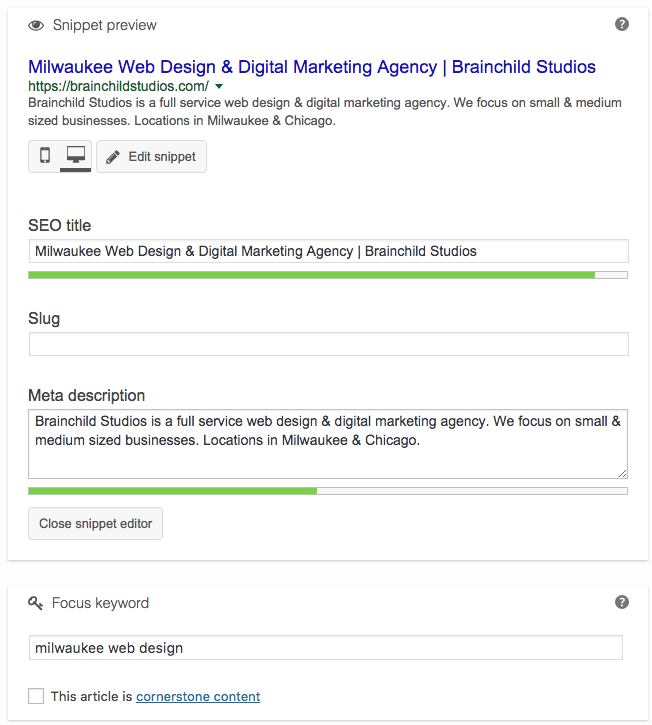
3. Create a Page for Every Product, Service and Location.
Stop trying to consolidate, it's not helpful for SEO and it's not helpful for local SEO. In order to apply product/service schema to each of your individual product/service offerings, they have to have their own page. So not only is this an overall SEO best practice, as it helps to paint a more clear sitemap for search engines and also helps your product/service pages rank for that specific offering, it opens the door to specific schema applications. Below are all of our service offerings, which can be found in our sitemap. If we had one page that said "Our Services" and no other individualized pages, do you think we'd ever rank for Local SEO or Social Media or Web Design with a web page labeled "Our Services?" Doubtful.

Similarly, if you have multiple locations, create a page for each location. How do you expect your Phoenix location to show up in search results if it's on the same page as your Chicago and Tampa locations? Exactly. It won't. So stop trying to make all your children share bunk beds and give each of them their own room. It might take a bit more work, but it will give them more space to mark their territory and be found when called upon. Now what was that you said about schema?
4. Use Local Business, Organization, Product & Service Schema.
At the very least, you should apply local business schema, or structured data markup to every web page to optimize your website for local SEO. It's near impossible to get into the infamous Google Local Pack without this. Local schema is additional code that you can add to the pages of your website to make it easier for search engines to understand who you are, what you do, where you're located and how you may be relevant to people who might be searching for your type of products or services.
Adding product and service schema to your website focuses more on the details of each of those products or services. Again, the entire mindset behind schema is speaking to a robot (search engines) in their own language. Simplify things for them. Yes, they might understand English, but it's their second language. So speak to them in their language for optimal local search results.
If you have schema on your site, or you're not sure, you can also test a URL on Google's Structured Data Testing Tool and see the break down of various schemas on your website. Here's an example of the schema listed on our web design page (local business, services and reviews):
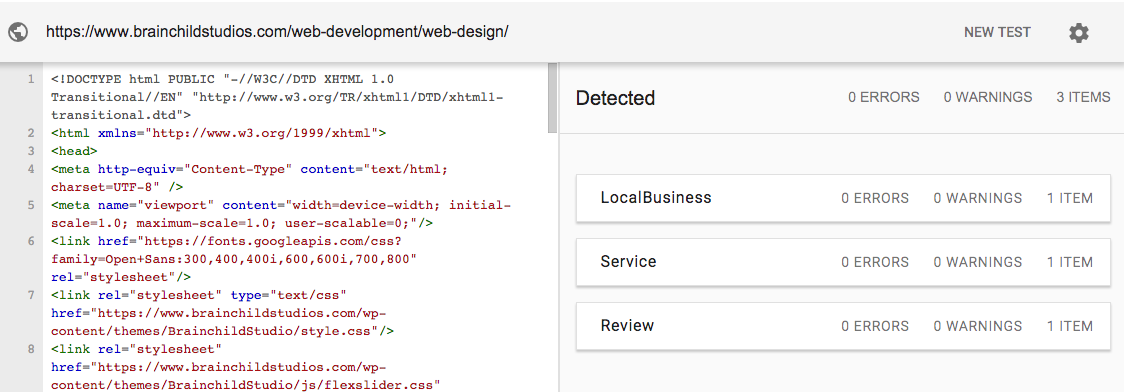
5. Claim Your Google My Business Page.
We've had plenty of run-ins with Google My Business (GMB), so if you find yourself banging your head against a brick wall, you're not alone. However, claiming your business listing and filling out the content for it is essential to your local SEO listing -- especially for your Google Local Pack and SERP results. Don't get discouraged if your business category isn't listed, while there are over 2,000 categories, they have some weird ones, so try your best to find the fit that makes the most sense for your business. Use both primary and LSI keywords wherever you can as you fill out your content as this counts for almost 20% of your chance of getting into the Local Pack.
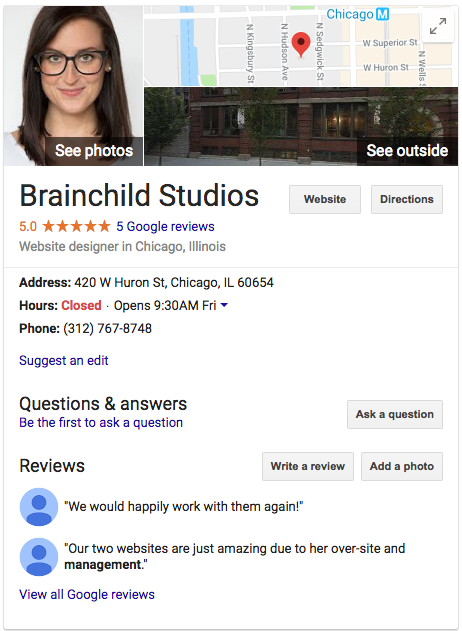
Again, if you have multiple locations, do yourself a favor and claim each of your GMBs. You can manage them all from one login, so it won't be a headache to update, but yes, you need to own each physical location for your business.
6. Update NAP Citations on Your Website.
NAP stands for Name, Address and Phone number. Take a look at how your business is listed in your Google My Business listing and make sure that it is listed EXACTLY the same way on every page of your website. This is commonly done in the footer of a website, but it's important that it's constructed in a way that the code for the footer still loads for each page to have the true effect.
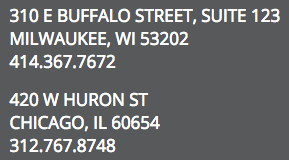
If you have multiple locations, then, as mentioned above, create a page for each location and apply the NAP relevant to that location to that page.
7. Add Your Business To Local Directories.
Local directory listings and citation building are a great way to optimize your website for local SEO, It can be a bit time consuming, but there are different tools out there (if you're willing to pay for them) that can help to make this a little less daunting. The key here is to make sure that every single entry is EXACTLY the same. So again, mirror the exact formatting and representation of your company from your GMB page and make sure to list your business the exact same way in your local directories. Moz Local provides a quick and free audit of your current status in a few major directories. However, services like Yext and WhiteSpark might provide more comprehensive options if you have deeper pockets.
8. Setup Social Media Signals.
If you don't have a Facebook business page, you should now. Having social media signals pointing to your location is another bonus when it comes to ranking for local SEO. You don't necessarily have to do a lot with it, but the sheer existence of the page is better than nothing. However, ideally you'll have a social media strategy that will help you to manage content for multiple locations, if that's relevant to your business.
9. Prioritize Reviews.
As you grow your business, you will want "votes of validation" that you are who you say you are, you do what you say you do and you are located where you say you're located. It's a bonus if people have rave reviews about your products and services as well. However, reviews are a great way to do this. When search engines are trying to figure out what the best results might be for a certain search inquiry, they're going to look at a number of factors in their algorithm and the number of reviews you have on Google, Yelp and Facebook are all going to be part of that consideration process.
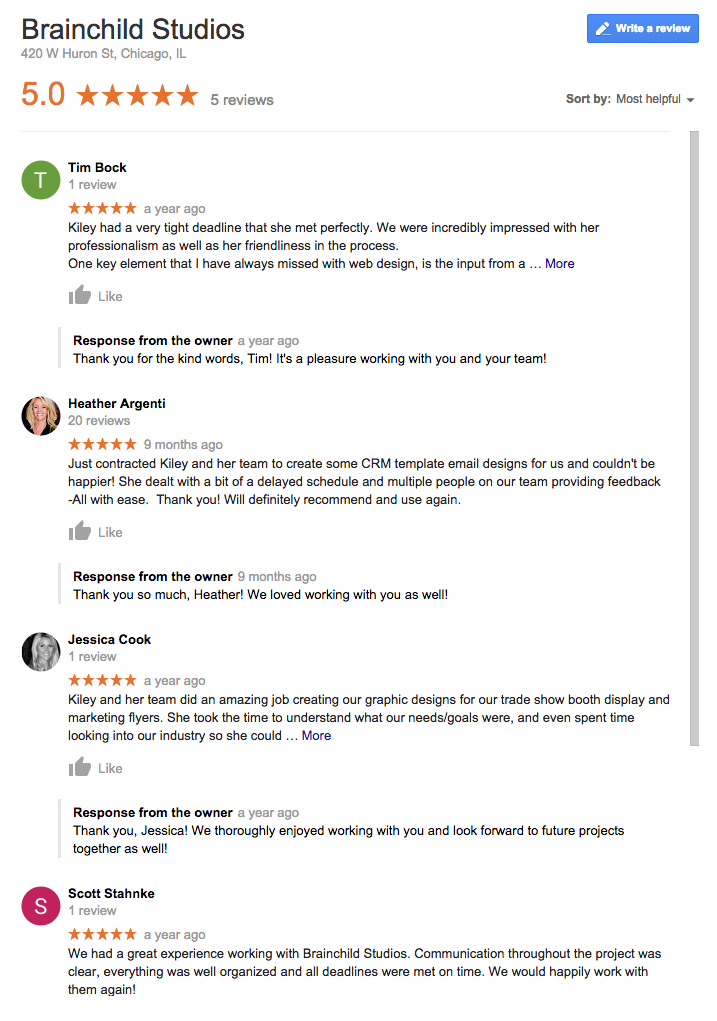
Yelp is always going to appear on the first page of Google. So play the game. Work on building your Yelp reviews as well as your Google reviews. Building up reviews on a the top search engine in the world, yes, always a good idea. And your Facebook page is likely to appear on the first page of Google when your brand name is searched for as well, so build up those reviews to help position you in a positive light! While reviews may not be on your physical website, they are a great way to optimize your website for local SEO.
10. Implement SEO Best Practices Throughout Your Website.
Yes, this might seem obvious -- and it is, but it is so often ignored. At the end of the day, if you add band-aids to a boat with holes, it might help, but it's not going to make it sail across the ocean. It will sink if it's not properly attended to. Websites are the same way. This is your home on the internet. Treat it with some TLC. Plus, the better search engine optimized your website, the better your content strategy, the better your blog posts, the more quality in-bound links you'll naturally drive. And you want to do drive quality links because they are a major ranking factor for local SEO as well as your natural rankings in SERPs.
With all of that said, we know this can be a bit overwhelming. Keep in mind that local SEO is just one part of a holistic digital strategy. If you'd like to chat about how to optimize your brand online, give us a shout!

Kiley
Founder & CEO
Kiley Peters is the Founder and CEO of Brainchild Studios, a boutique audience research, content strategy, and website creation agency primarily serving brands targeting Millennial Moms or business owners. She is also the Founder of the Work From Home Playbook, a series of online courses guiding aspiring entrepreneurial moms through the steps of starting a virtual business. She also launched the Brainchild Fund, a nonprofit initiative to support women and girls in business and entrepreneurship Follow her on Instagram.
more posts by Kiley →Related posts
-
 Small Business
Small Business -
 Content Marketing, SEO
Content Marketing, SEO -
 Small Business, SEO, Local SEO
Small Business, SEO, Local SEO -

 Content Marketing, SEO
Content Marketing, SEO -

 SEO, Digital Marketing
SEO, Digital Marketing -

 Content Marketing, SEO
Content Marketing, SEO -

 SEO, Websites, Local SEO
SEO, Websites, Local SEO -

 Content Marketing, SEO
Content Marketing, SEO -

 Content Marketing, SEO
Content Marketing, SEO -

 SEO, Websites
SEO, Websites -

 Content Marketing, SEO, Digital Marketing
Content Marketing, SEO, Digital Marketing -

 Small Business, SEO, Local SEO
Small Business, SEO, Local SEO -


 Small Business, SEO, Local SEO
Small Business, SEO, Local SEO -

 Content Marketing, SEO, Digital Marketing
Content Marketing, SEO, Digital Marketing -

 Content Marketing, SEO, Digital Marketing
Content Marketing, SEO, Digital Marketing




Leave a Reply